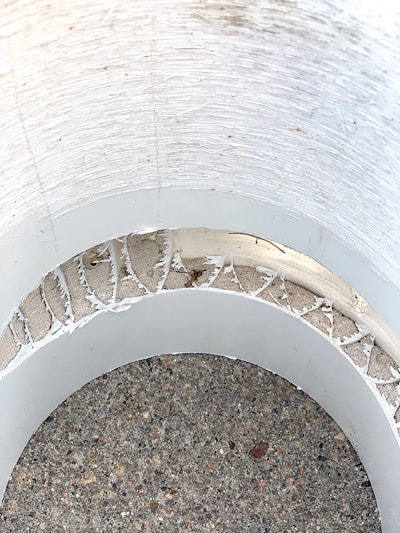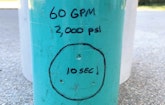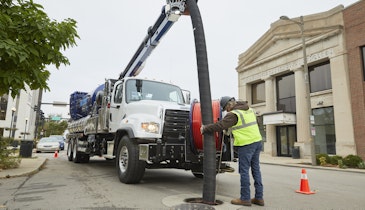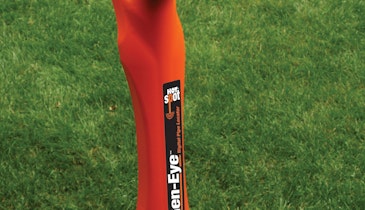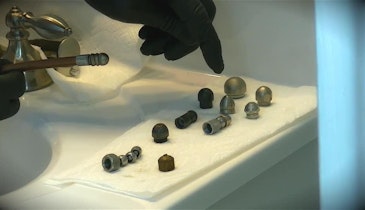
A proofing skid keeps the nozzle centered in this vitrified clay pipe, helping to clean the pipe periphery equally. It also helps guide the nozzle, and indicates when there is a blockage.
Interested in Waterblasting?
Get Waterblasting articles, news and videos right in your inbox! Sign up now.
Waterblasting + Get AlertsDid you know that high-pressure jetting of sewer pipes can damage some pipe materials?
“All sewer pipe can be damaged,” says Kent Carlson, vice president of the National Clay Pipe Institute. Whether fabricated out of clay, plastic, iron, fiberglass, asbestos or some other material, a sewer pipe ultimately can only withstand so much pinpoint pressure from a nozzle before failing.
The real question, Carlson says, is how much assault a segment of pipe can withstand before it fails. The answer varies from product to product, and therein lies a problem for cleaners and those who maintainer sewer systems.
Because Carlson is an official of the national organization for clay pipe manufacturers, you may be thinking: I can see where this is going. But you would be wrong. Carlson spent 30-plus years with the Los Angeles sewer department, where he was the longtime operations manager. The man knows his sewer pipe.
Carlson joined the U.S. Navy right out of high school in 1978. After his Navy stint, he worked in shipyards up and down the West Coast before becoming an LA municipal employee as a machinist in a water treatment plant. Before long, he transferred to the wastewater side of municipal services and began his rise to the top. Two years ago, the 60-year-old industry veteran took his accumulated expertise to the National Clay Pipe Institute. He also serves on three ASTM technical committees.
The LA collections system — deemed the world’s largest — proved to be an expansive training ground for Carlson. The system contains 6,700 miles of wastewater collection pipe, the oldest of which dates to 1883. Working there, Carlson was able to become thoroughly acquainted with the industry and use his machinist skills to craft pipe-cleaning tools.
“Thirty-three years ago, there wasn’t much going on in sewer cleaning,” he recalls. “We had rudimentary nozzles, mechanical routers, hand rods — everything the same since the 1940s. The sewer industry was stagnant for a long time in respect to cleaning.”
As a submarine systems machinist, Carlson was immersed in the technology of handling human waste in an undersea craft. It was, he says, “very technical work.” Tutored in the necessity of keeping systems operating, even when they failed in the middle of the ocean, he brought to his work in LA a zeal for finding solutions.
“I love prototyping,” Carlson says. “At the city of LA, I started making my own designs for nozzles. I had my own in-house testing facility and constantly tweaked flow characteristics of nozzles so they would clean more efficiently. That was the thing: to have them clean more efficiently.”
Along the way, he began to see differences in the durability of pipe products. LA’s sewer system is 95% vitrified clay, but Carlson was open to any type of new or replacement pipe. The problem was that other types didn’t hold up as well in testing. “We had an aggressive approach to cleaning. We would be given other types of pipe — PVC, HDPE, plastic truss and so on. We’d run our cleaning tools through the pipe and it wouldn’t survive the test.”
The dilemma was not that the other kinds of pipe couldn’t safely carry sewage or function satisfactorily for decades. Manufacturers claimed their products were convenient to install, compatible with other pipe materials, or resistant to corrosion and chemicals — and their claims were true. The difficulty was the pipe couldn’t withstand rigorous maintenance routines, including mechanical, hydromechanical and high-velocity hydro cleaning.
Hydromechanical cutters and ceramic nozzles today are “incredibly more efficient and deliver water with more impact force,” Carlson says. “They can chop up roots and evacuate calcium. The number of jets has been reduced, but more water is coming out of each one. The angles have been increased from 6 degrees to much higher, reducing the jet stream distance to the pipe surface and increasing the force when the water strikes.”
All these advancements, however, are a double-edged sword, according to Carlson. “The dynamics changed. You started seeing warnings coming from agencies like the EPA saying, ‘Be careful. Nozzles can damage pipe.’” Yet the warnings were so muted, they were frequently unheard. Even today, the damage warnings are hard to find. The following are some that Carlson has ferreted out in recent years:
Cured-in-place pipe “should never be mechanically cleaned,” according to an Insituform Technologies cleaning guide. More to the point, the guide says when CIPP is jetted, “the nozzle pressure should never exceed 2,000 psi or damage could occur.”
Glass-reinforced polyester, or fiberglass, pipe should be jetted “with due care to prevent the inner surface of the pipes from being damaged,” according to an operator’s manual by fiberglass pipe manufacturer Amiblu. To prevent damage, the manual goes on to limit pressure to the 870 to 1,450 psi range. It also says operators should “avoid stopping of the nozzle” during operation — blasting in place — and that the angle of the stream of water should be kept as small as possible.
Plastic pipe used in gravity sewer systems should be jetted “with utmost care,” according to an instruction manual produced by nozzle distributor Enz USA. “Due to the new thin-walled pipe products being installed these days, possible pipe damage can occur if used with too high a water pressure. As a rough guideline, do not exceed 1,400 psi of water pressure at the tool.”
So, there are red flags out there. While all pipes can be damaged by waterjetting, some pipes are particularly endangered when pressures and water volume are in excess of 2,000 psi at 60 gpm — an average jetting pressure and flow. High-pressure jets can penetrate even vitrified clay pipe, though its manufacturers claim a damaging stream would have to exceed 5,000 psi flowing at more than 125 gpm.
This low-key treatment of jetting’s damaging potential sets operators up for failure. “I think a lot of people don’t know,” Carlson says. “Because they don’t know the impact of jetting on different pipes, they damage pipes and don’t even realize it. There’s a new generation of cleaning folk and they don’t know it.”
The fact is a sewer system using a mix of pipe is problematic when it comes time to clean it. “Spot repairs using pipe of a different material than the original are especially vulnerable to being damaged. Unless a system’s repair group is joined at the hip with the IT group that keeps the database current, the cleaning crew doesn’t know it’s there,” Carlson says. He notes that the Environmental Protection Agency has addressed this issue. An agency guide on maintaining sanitary sewer systems states that “a suitable pipe identification system should be in place to warn the operator where plastic pipe has been installed.”
Even when a cleaning crew correctly identifies a vulnerable length of sewer line in a system, it has to switch out a nozzle or throttle down the pressure to proceed. “Then you have lost the cleaning efficiency of that nozzle,” Carlson says. Consequently, at the end of a job, some segments of a system have been restored to full capacity while other segments are only partly cleaned.
“I do not blame the nozzle folks,” Carlson says of the dilemma. On the other hand, he believes pipe manufacturers should more fully disclose the danger to their products from certain cleaning procedures and equipment. “I’ve been looking at this a long time, and I don’t see a pattern of disclosure. But in the end, it’s up to owners of systems to research the matter and make sure a cleaning process works for them and doesn’t mess up their pipes.”
So the moral is: Know thy sewer pipe and have it cleaned in a way that will do it no harm.
